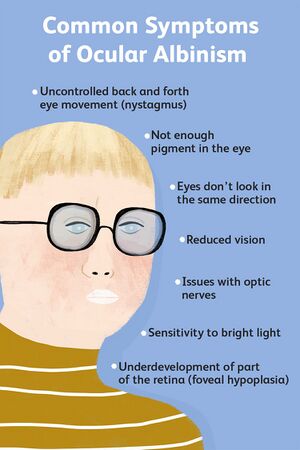Albinism: Difference between revisions
A Aishwarya (talk | contribs) No edit summary |
A Aishwarya (talk | contribs) No edit summary |
||
| Line 36: | Line 36: | ||
== Clinical Presentation == | == Clinical Presentation == | ||
[[File:Ocular-albinism-5201966 final rev-2a520b29d6fe41e98ee71f27c82ba674.jpg|none|thumb]] | |||
== Management/Interventions == | == Management/Interventions == | ||
Revision as of 17:55, 25 November 2023
This article or area is currently under construction and may only be partially complete. Please come back soon to see the finished work! (25/11/2023)
Introduction[edit | edit source]
Albinism, a latin word albus that means "white" is a genetic condition characterized by a lack of melanin. Melanin is a pigment that gives color to the hair, skin and eyes. It is an inherited when an individual receives two copies of a recessive gene that causes a lack of melanin production. There are different types of albinism.
- Oculocutaneous Albinism (OCA): This affects the person's skin, hair, and eyes. Due to little or no melanin in these areas, the skin and hair color is very light with blue or violet eyes. OCA is further subdivided into (based on mutations invovled):
- OCA1
- OCA2
- OCA3
- OCA4
- Ocular Albinism (OA): This primarily affects the eye. These individuals may have little or no pigmentation in the iris and retina that leads to vision problem. In OA the skin and hair colour might appear normal. This is associated with issues such as Nystagmus and strabismus.[1]
Relavent anatomy[edit | edit source]
Sub-Types of Albinism[edit | edit source]
OCA1[edit | edit source]
This is caused by a defect in the tyrosinase enzyme. There are two subtypes of OCA1:
- OCA1a. People with OCA1a have a complete absence of melanin. People with this subtype have white hair, very pale skin, and light eyes.
- OCA1b. People with OCA1b produce some melanin. They have light-colored skin, hair, and eyes. Their coloring may increase as they age.
OCA2[edit | edit source]
OCA2 is less severe than OCA1. It’s caused by a defect in the OCA2 gene that results in reduced melanin production. People with OCA2 are born with light coloring and skin. Their hair may be yellow, blond, or light brown. OCA2 is most common in people of African descent and Native Americans.
OCA1 and OCA2 are the most commonTrusted Source subtypes globally. Around 1 in 40,000 people have OCA1, and 1 in 39,000 people have OCA2.
OCA3[edit | edit source]
OCA3 is the result of a defect in the TYRP1 gene. It usually affects people with dark skin, particularly Black people in southern Africa. People with OCA3 have reddish-brown skin, reddish hair, and hazel or brown eyes.
OCA4[edit | edit source]
OCA4 is caused by a defect in the SLC45A2 protein. It results in the minimal production of melanin and commonly appears in people of East Asian descent. People with OCA4 have symptoms similar to those in people with OCA2.[1]
Causes of albinism[edit | edit source]
Clinical Presentation[edit | edit source]
Management/Interventions[edit | edit source]
Current Literature[edit | edit source]
Refrences[edit | edit source]
- ↑ 1.0 1.1 Marçon CR, Maia M. Albinism: epidemiology, genetics, cutaneous characterization, psychosocial factors. Anais brasileiros de dermatologia. 2019 Dec 9;94:503-20.










